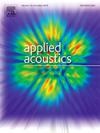Low-frequency absorption band in a thin acoustic metamaterial using acoustic black hole termination
IF 3.4
2区 物理与天体物理
Q1 ACOUSTICS
引用次数: 0
Abstract
The proposed metamaterial is a multi-pancake absorber, composed of periodically arranged thin annular cavities, with an alternative main pore profile that combines a constant section and an acoustic black hole termination to achieve an effective absorption band at low frequencies. The constant section at the opening enables low-frequency sound absorption, while the short acoustic black hole termination allows absorption band without a high-frequency shift. An equivalent mass-spring model using a single equivalent stiffness to represent the whole constant main pore section is proposed. This approach simplifies modeling and reduces computation time while capturing the metamaterial’s multiple resonances and visualizing mass velocities at resonance frequencies, providing insight into its acoustic behavior. Validation is carried out using thermo-visco-acoustic finite element simulations and impedance tube measurements. First, profiles with an acoustic black hole termination of one to three main pores are studied to gain insight into the formation of combined modes and their impact on absorption. Next, optimizations are performed to achieve broadband absorption, resulting in the two best profiles. The first profile exhibits a 300 Hz absorption band starting at 550 Hz, while the second achieves a broader 500 Hz band at slightly higher frequencies, for a 3-cm thick material.
求助全文
约1分钟内获得全文
求助全文
来源期刊

Applied Acoustics
物理-声学
CiteScore
7.40
自引率
11.80%
发文量
618
审稿时长
7.5 months
期刊介绍:
Since its launch in 1968, Applied Acoustics has been publishing high quality research papers providing state-of-the-art coverage of research findings for engineers and scientists involved in applications of acoustics in the widest sense.
Applied Acoustics looks not only at recent developments in the understanding of acoustics but also at ways of exploiting that understanding. The Journal aims to encourage the exchange of practical experience through publication and in so doing creates a fund of technological information that can be used for solving related problems. The presentation of information in graphical or tabular form is especially encouraged. If a report of a mathematical development is a necessary part of a paper it is important to ensure that it is there only as an integral part of a practical solution to a problem and is supported by data. Applied Acoustics encourages the exchange of practical experience in the following ways: • Complete Papers • Short Technical Notes • Review Articles; and thereby provides a wealth of technological information that can be used to solve related problems.
Manuscripts that address all fields of applications of acoustics ranging from medicine and NDT to the environment and buildings are welcome.
 求助内容:
求助内容: 应助结果提醒方式:
应助结果提醒方式:


